Coordinated Planning of Soft Open Points and Energy Storage Systems to Enhance Flexibility of Distribution Networks
Abstract
1. Introduction
2. Distribution Network Flexibility Resources and Flexibility Evaluation Indicators
2.1. Distribution Network Flexibility Supply and Demand
2.2. Distribution Network Flexibility Resources
2.2.1. Networked Flexibility Resource
2.2.2. Nodal Flexibility Resource
2.3. Distribution Network Flexibility Indicators
2.3.1. Traditional Flexibility Indicators
- (1)
- Net Load Adaptation Ratio
- (2)
- Line Capacity Margin
2.3.2. Distributed Generation Consumption Rate
2.3.3. Distributed Generation Volatility
3. Two-Tier Coordinated Planning of SOP and ESS Considering Flexibility Enhancement of Active Distribution Networks
3.1. Scenario Modeling Considering the Uncertainty of Wind Power and Photovoltaic Generation
3.1.1. Using Wasserstein Distance as the Loss Function of Discriminators
3.1.2. Conditional Deep Convolutional Generative Adversarial Networks
3.1.3. Generation of Results for Wind Power and PV Scenarios under Specified Labels
3.2. Two-Layer Planning Model of SOP and ESS
3.2.1. Upper-Layer Planning Model
3.2.2. Lower Layer Planning Model
- (1)
- DG operating constraints
- (2)
- System tidal current constraints
- (3)
- Operational safety constraints
3.3. Model Solving Methods
- (1)
- The parameters of ADN, PV, wind, and load data are inputted, and typical scenarios are generated according to the C-DCGAN method.
- (2)
- The SOP and ESS locations and capacities are encoded, and a population of M chromosomes is initially randomly generated.
- (3)
- The average flexibility of ADN containing SOPs and ESSs is calculated using cone planning.
- (4)
- The fitness values for each chromosome are calculated.
- (5)
- The establishment of a robust gene pool, the updating of the historical optimal values of the chromosomes, and the updating of the optimal values of the population are conducted.
- (6)
- The current population is subjected to selection, gene crossover, and mutation operations, resulting in the generation of a new population of M chromosomes.
- (7)
- The convergence condition is evaluated. If it is satisfied, the optimal value of the population is output. Otherwise, the process is repeated at step 3.
4. Simulation Analysis
4.1. Analysis of the Flexibility of Different Planning Schemes
4.2. Economic Analysis of Different Planning Schemes
4.3. Planning Results
4.4. Analysis of Voltage Quality under Different Planning Schemes
4.5. Comprehensive Benefits Analysis
4.6. Validation of Model Generalizability
5. Conclusions
- The coordinated planning of SOP and ESS offers superior benefits in terms of enhancing the flexibility and economy of ADN, as well as improving the voltage level of ADN, in comparison to separate individual planning. In comparison to the original plan, the degree of flexibility has been enhanced by 36.92%, the economy of ADN has been improved by 2.58%, and the voltage level has been increased by 33.5%.
- From the perspective of large-scale penetration of DG, the proposed indicators of DG consumption rate and DG volatility can be employed to comprehensively assess the flexibility of the power side of ADN. Furthermore, they can be utilized as an optimization target to formulate a more reasonable SOP and ESS configuration scheme.
Author Contributions
Funding
Institutional Review Board Statement
Informed Consent Statement
Data Availability Statement
Conflicts of Interest
Appendix A
| Node i | Node j | Branch Impedance | Node j Load | Node i | Node j | Branch Impedance | Node j Load |
| 1 | 2 | 0.0922 + j0.0470 | 100 + j60 | 17 | 18 | 0.3720 + j0.5740 | 90 + j40 |
| 2 | 3 | 0.4930 + j0.2511 | 90 + j40 | 2 | 19 | 0.1640 + j0.1565 | 90 + j40 |
| 3 | 4 | 0.3660 + j0.1864 | 120 + j80 | 19 | 20 | 1.5042 + j1.3554 | 90 + j40 |
| 4 | 5 | 0.3811 + j0.1941 | 60 + j30 | 20 | 21 | 0.4095 + j0.4784 | 90 + j40 |
| 5 | 6 | 0.8190 + j0.7070 | 60 + j20 | 21 | 22 | 0.7089 + j0.9373 | 90 + j40 |
| 6 | 7 | 0.1872 + j0.6188 | 200 + j100 | 3 | 23 | 0.4512 + j0.3083 | 90 + j50 |
| 7 | 8 | 0.7144 + j0.2351 | 200 + j100 | 23 | 24 | 0.8980 + j0.7091 | 420 + j200 |
| 8 | 9 | 1.0300 + j0.7400 | 60 + j20 | 24 | 25 | 0.8960 + j0.7011 | 420 + j200 |
| 9 | 10 | 1.0440 + j0.7400 | 60 + j20 | 6 | 26 | 0.2030 + j0.1034 | 60 + j25 |
| 10 | 11 | 0.1966 + j0.0650 | 45 + j30 | 26 | 27 | 0.2842 + j0.1447 | 60 + j25 |
| 11 | 12 | 0.3744 + j0.1238 | 60 + j35 | 27 | 28 | 1.0590 + j0.9337 | 60 + j20 |
| 12 | 13 | 1.4680 + j1.1550 | 60 + j35 | 28 | 29 | 0.8042 + j0.7006 | 120 + j70 |
| 13 | 14 | 0.5416 + j0.7129 | 120 + j80 | 29 | 30 | 0.5075 + j0.2585 | 200 + j600 |
| 14 | 15 | 0.5910 + j0.5260 | 60 + j10 | 30 | 31 | 0.9744 + j0.9030 | 150 + j70 |
| 15 | 16 | 0.7463 + j0.5450 | 60 + j20 | 31 | 32 | 0.3105 + j0.3619 | 210 + j100 |
| 16 | 17 | 1.2890 + j1.7210 | 60 + j20 | 32 | 33 | 0.3410 + j0.5362 | 60 + j40 |
| 8 | 21 | 2 + j2 | contact switch | The network comprises 32 branch circuits, 5 contact switching branch circuits, and 1 power supply network. The first base voltage is 12.66 kV, the three-phase power quasi-value is 10MVA, and the total load of the network is 5084.26 + 52547.32 kVA. | |||
| 9 | 15 | 2 + j2 | |||||
| 12 | 22 | 2 + j2 | |||||
| 18 | 33 | 0.5 + j0.5 | |||||
| 25 | 29 | 0.5 + j0.5 | |||||
References
- Yang, X.D.; Xu, C.B.; He, H.B.; Yao, W.; Wen, J.; Zhang, Y. Flexibility provisions in active distribution networks with uncertainties. IEEE Trans. Sustain. Energy 2021, 12, 553–567. [Google Scholar] [CrossRef]
- Cao, W.; Wu, J.; Jenkins, N.; Wang, C.; Green, T. Benefits analysis of soft open points for electrical distribution network operation. Appl. Energy 2016, 16, 36–47. [Google Scholar] [CrossRef]
- Tsai, Y.S.; Chen, C.W.; Kuo, C.C.; Chen, H.C. Design of an Enhanced Dynamic Regulation Controller Considering the State of Charge of Battery Energy Storage Systems. Appl. Sci. 2024, 14, 2155. [Google Scholar] [CrossRef]
- Huang, C.; Chen, Y.W.; Mao, Z.P.; Sun, J.; Zha, X. Joint Access Planning for Flexible Multi-state Switching and Distributed Energy Storage System. Power Syst. Autom. 2022, 46, 29–37. [Google Scholar]
- Laaksonen, H.; Khajeh, H.; Parthasarathy, C.; Shafie-Khah, M.; Hatziargyriou, N. Towards flexible distribution systems: Future adaptive management schemes. Appl. Sci. 2021, 11, 3709. [Google Scholar] [CrossRef]
- Liu, L.; Huang, W.; Chen, Z.; Jiang, Y.; Huang, J.; Chen, F. Novel joint planning of long and short-term energy storage for power systems considering flexibility supply-demand balance. Power Grid Technol. 2024, 1–13. [Google Scholar] [CrossRef]
- Cheng, S.; Fu, T.; Li, F.; Gao, X.; Wang, C. Flexible supply-demand co-planning for distribution networks with high penetration of renewable energy. Power Syst. Prot. Control 2023, 51, 1–12. [Google Scholar]
- Xiangwu, Y.; Ruojin, L. Flexible Coordination Optimization Scheduling of Active Distribution Network with Smart Load. IEEE Access 2020, 8, 59145–59157. [Google Scholar]
- Ma, W.; Gao, H.; Li, H.; Liu, Y.; Liu, J. Flexibility assessment and optimal scheduling model of distribution network considering Soft Open Point. Power Grid Technol. 2019, 43, 3935–3943. [Google Scholar]
- Xue, F.; Ma, L.; Zhu, H.; Shi, J.; Qiao, W. Bi-level programming of distributed generations in flexible distribution network with sop optimization. Power Syst. Technol. 2020, 32, 109–115. [Google Scholar]
- Zheng, H.; Shi, T. Bilayer optimization of distribution network based on Soft Open Point and reactive power compensation device. Power Syst. Autom. 2019, 43, 117–126. [Google Scholar]
- Ji, H.; Wang, C.; Li, P.; Zhao, J.; Song, G.; Wu, J. Quantified flexibility evaluation of soft open points to improve distributed generator penetration in active distribution networks based on difference-of-convex programming. Appl. Energy 2018, 218, 338–348. [Google Scholar] [CrossRef]
- Zhu, X.; Lu, G.; Xie, W. Robust planning of distribution network energy storage considering source-network-load flexibility resources. Power Autom. Equip. 2021, 41, 8–16. [Google Scholar]
- Sun, W.; Song, H.; Qin, Y.; Heng, L. Optimal allocation of energy storage considering the uncertainty of flexibility supply and demand. Power Grid Technol. 2020, 44, 4486–4497. [Google Scholar]
- Guo, Y.; Wu, Q.; Gao, H.; Chen, X.; Østergaard, J.; Xin, H. MPC-based coordinated voltage regulation for distribution networks with distributed generation and energy storage system. IEEE Trans. Sustain. Energy 2019, 10, 1731–1739. [Google Scholar] [CrossRef]
- Chongbo, S.; Jingru, L.; Kai, Y. A Joint Optimization Method of Intelligent Soft Open Point and Energy Storage System in Distribution Grid Based on Interval Optimization. High Volt. Eng. 2021, 47, 45–54. [Google Scholar]
- Pamshetti, V.B.; Singh, S.P. Coordinated allocation of BESS and SOP in high PV penetrated distribution network incorporating DR and CVR schemes. IEEE Syst. J. 2022, 16, 420–430. [Google Scholar] [CrossRef]
- Wang, P.; Li, H.; Zhang, P. Joint Planning of Soft Open Point and Energy Storage in Distribution Networks with Source-Load Imbalance Characteristics. Power Syst. Autom. 2024, 1–15. [Google Scholar]
- Kemeng, C.H.; Xi, X.; Peigen, T.I. A comprehensive optimization method for planning and operation of building-integrated photovoltaic storage systems. Chin. J. Electr. Eng. 2023, 43, 5001–5012. [Google Scholar]
- He, Y.; Yang, X.; Wu, H.B. Coordinated Planning of Soft Open Point and Energy Storage System for Flexibility Enhancement of New Distribution System. Power Syst. Autom. 2023, 47, 142–150. [Google Scholar]
- Mohammedi, R.D.; Kouzou, A.; Mosbah, M.; Souli, A.; Rodriguez, J.; Abdelrahem, M. Allocation and Sizing of DSTATCOM with Renewable Energy Systems and Load Uncertainty Using Enhanced Gray Wolf Optimization. Appl. Sci. 2024, 14, 556. [Google Scholar] [CrossRef]
- Zhang, C.; Shao, Z.; Chen, F.; Jiang, C.; Feng, J. A data migration method for new energy generation scenarios based on conditional deep convolutional generative adversarial network. Power Grid Technol. 2022, 46, 2182–2190. [Google Scholar]
- Ha, M.P.; Nazari-Heris, M.; Mohammadi-Ivatloo, B.; Seyedi, H. A hybrid genetic particle swarm optimization for distributed generation allocation in power distribution networks. Energy 2020, 209, 118218. [Google Scholar]
- Xu, Y.; Han, J.; Yin, Z.; Liu, Q.; Dai, C.; Ji, Z. Voltage and Reactive Power-Optimization Model for Active Distribution Networks Based on Second-Order Cone Algorithm. Computers 2024, 13, 59. [Google Scholar] [CrossRef]
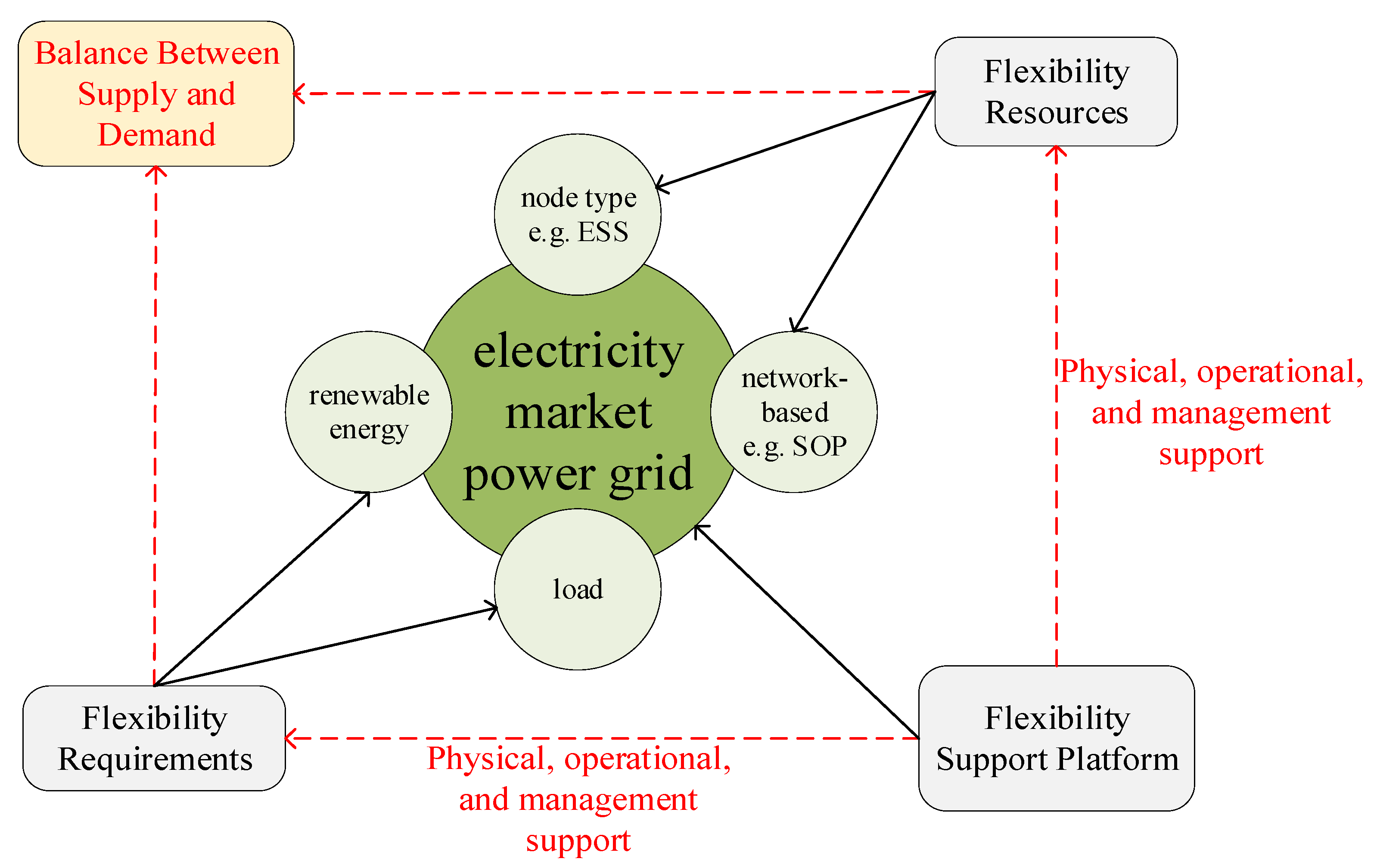

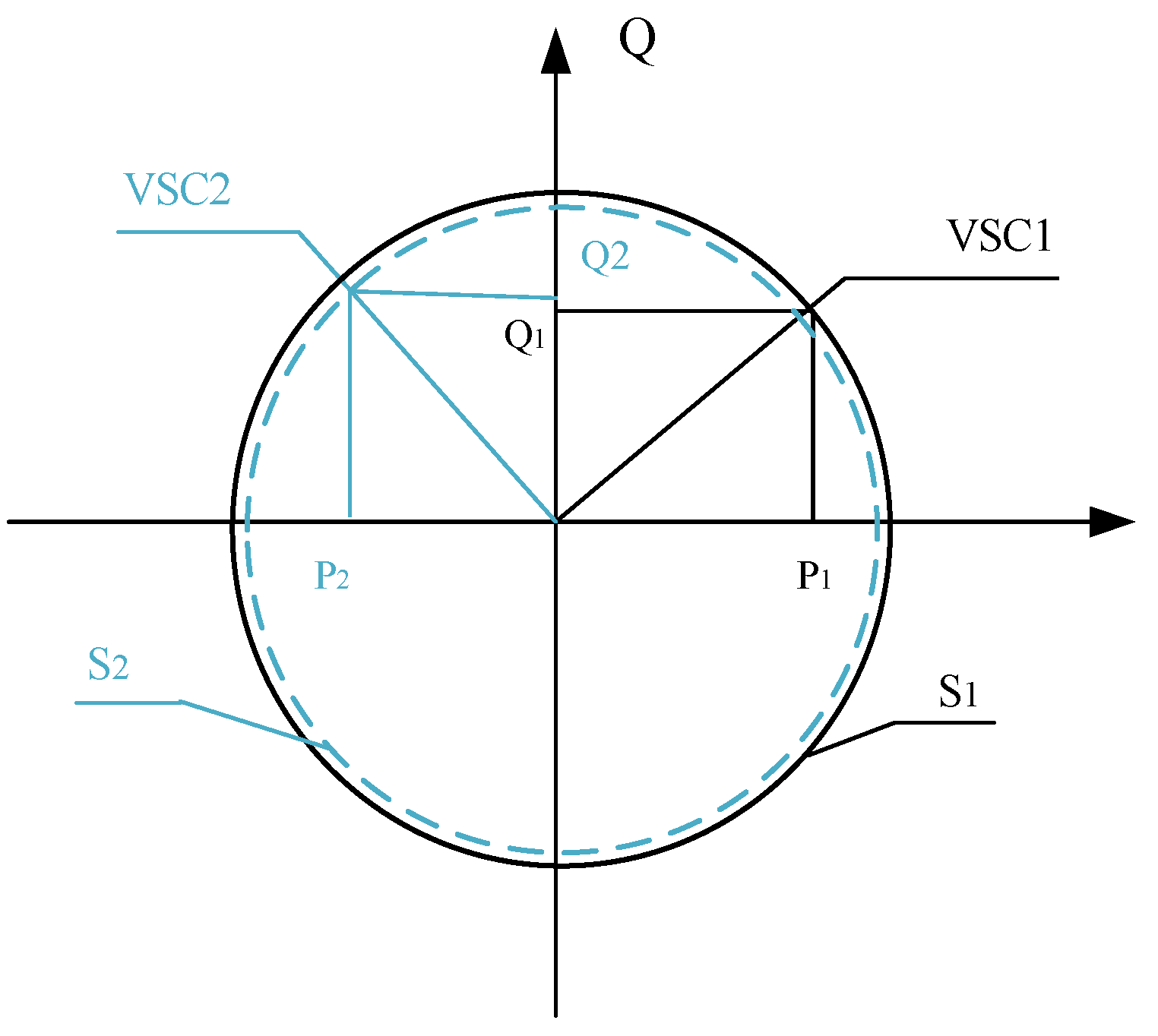
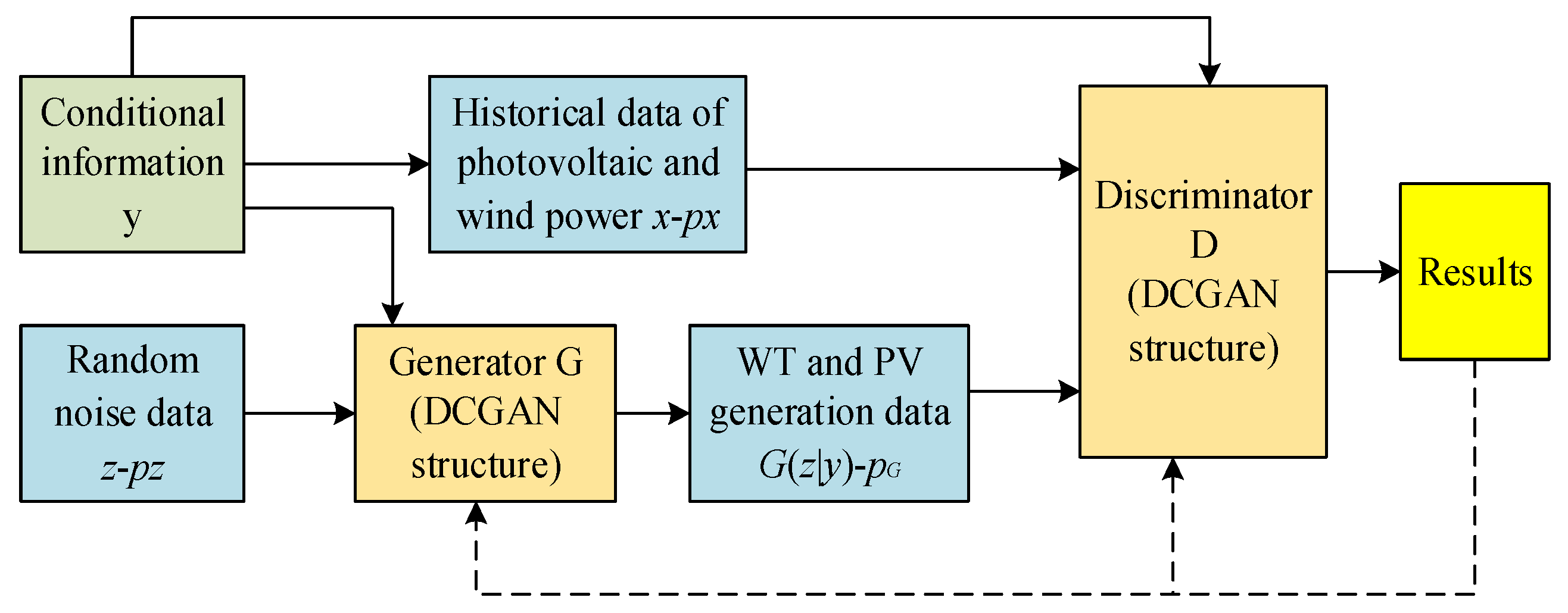
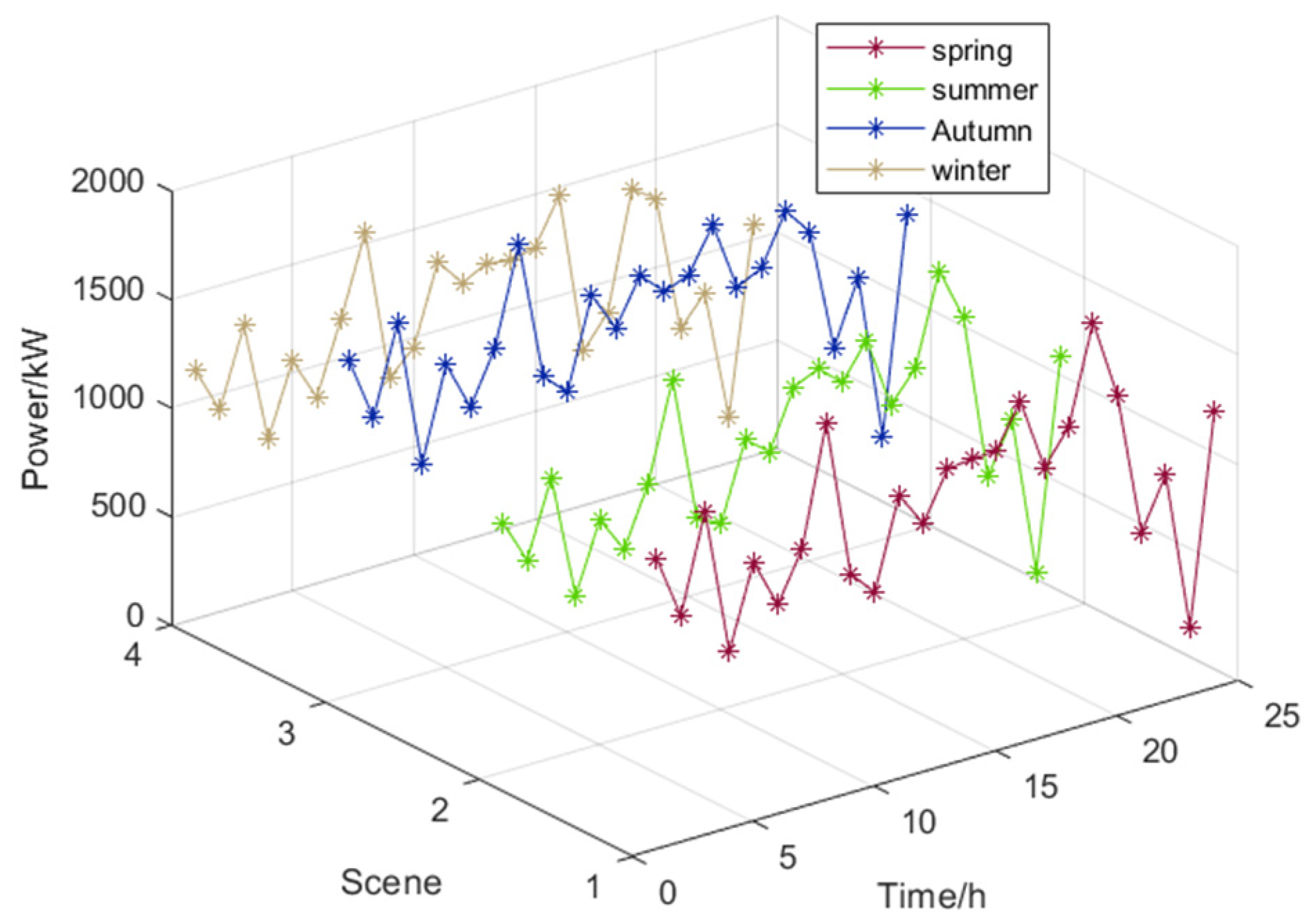
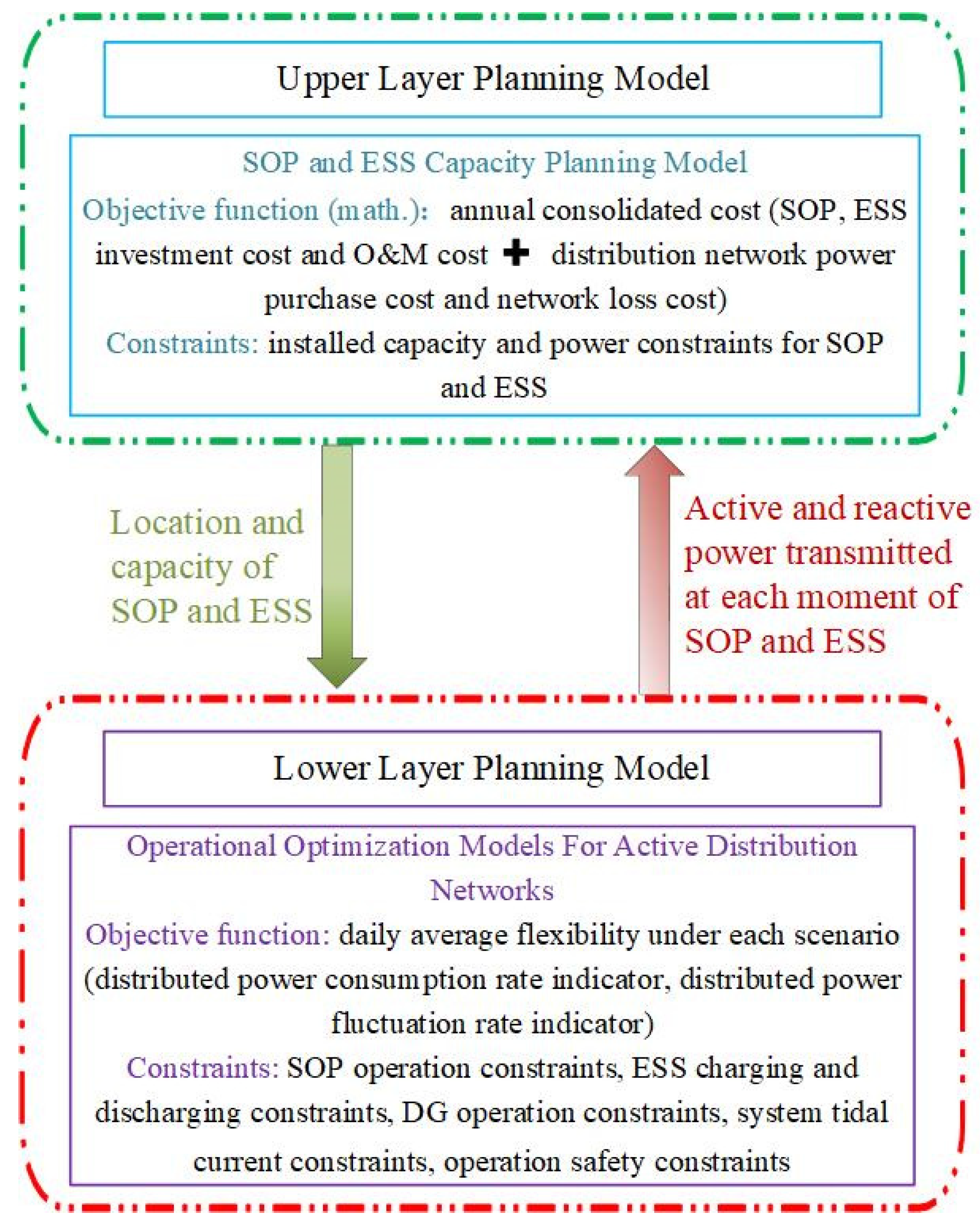
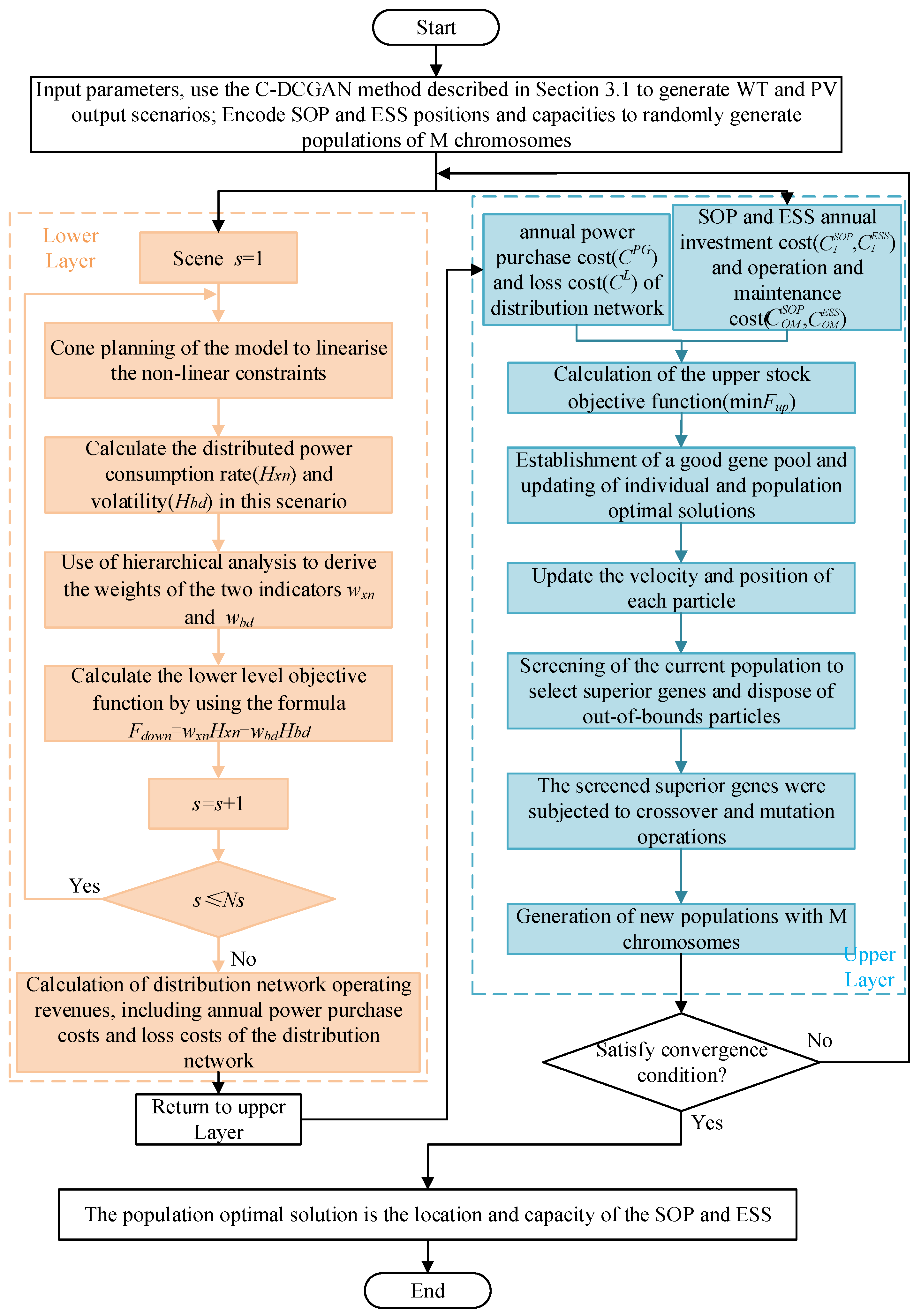
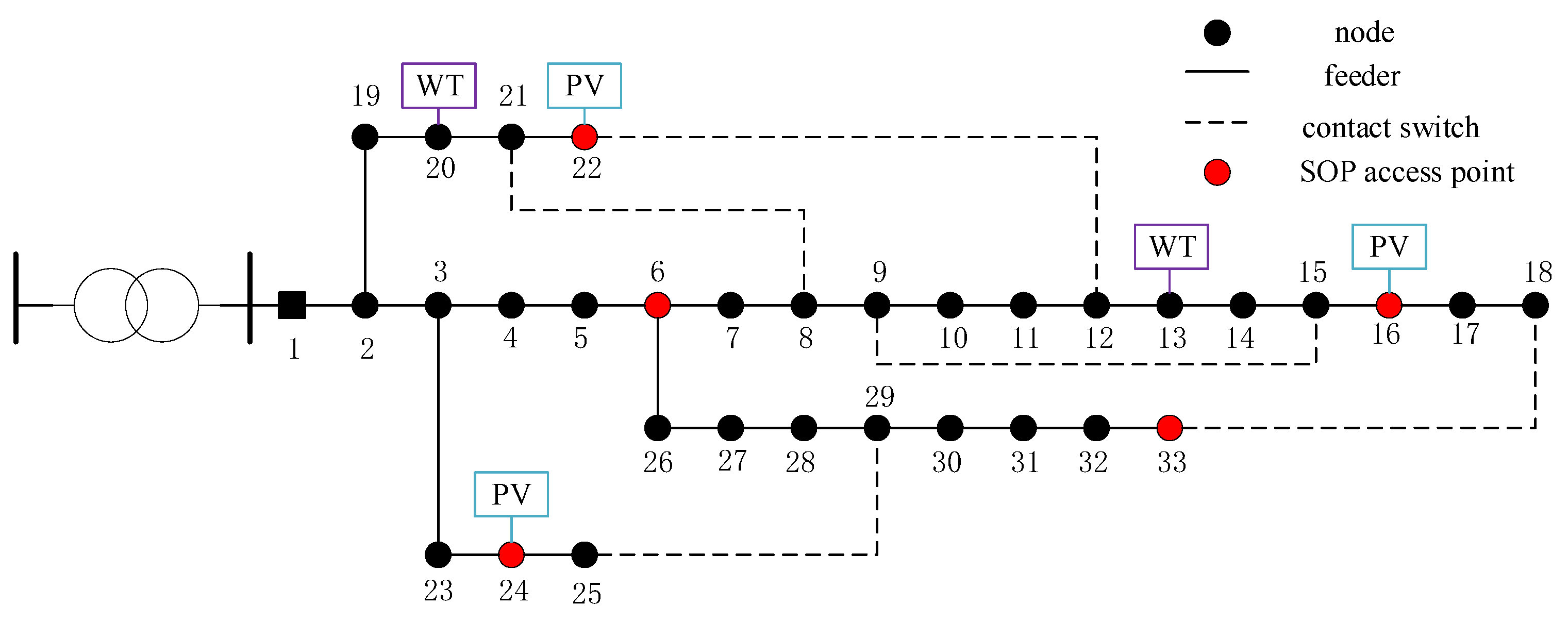
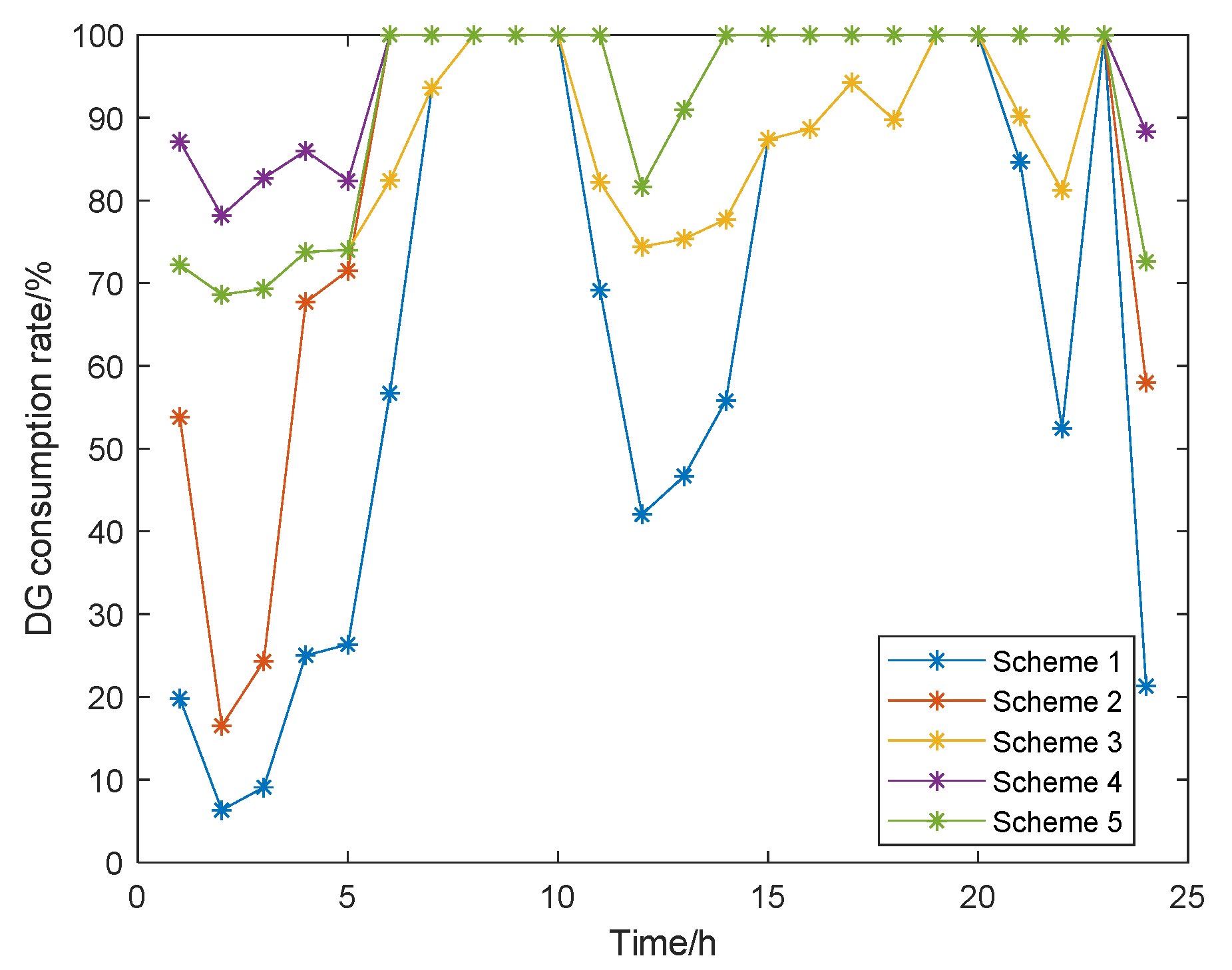
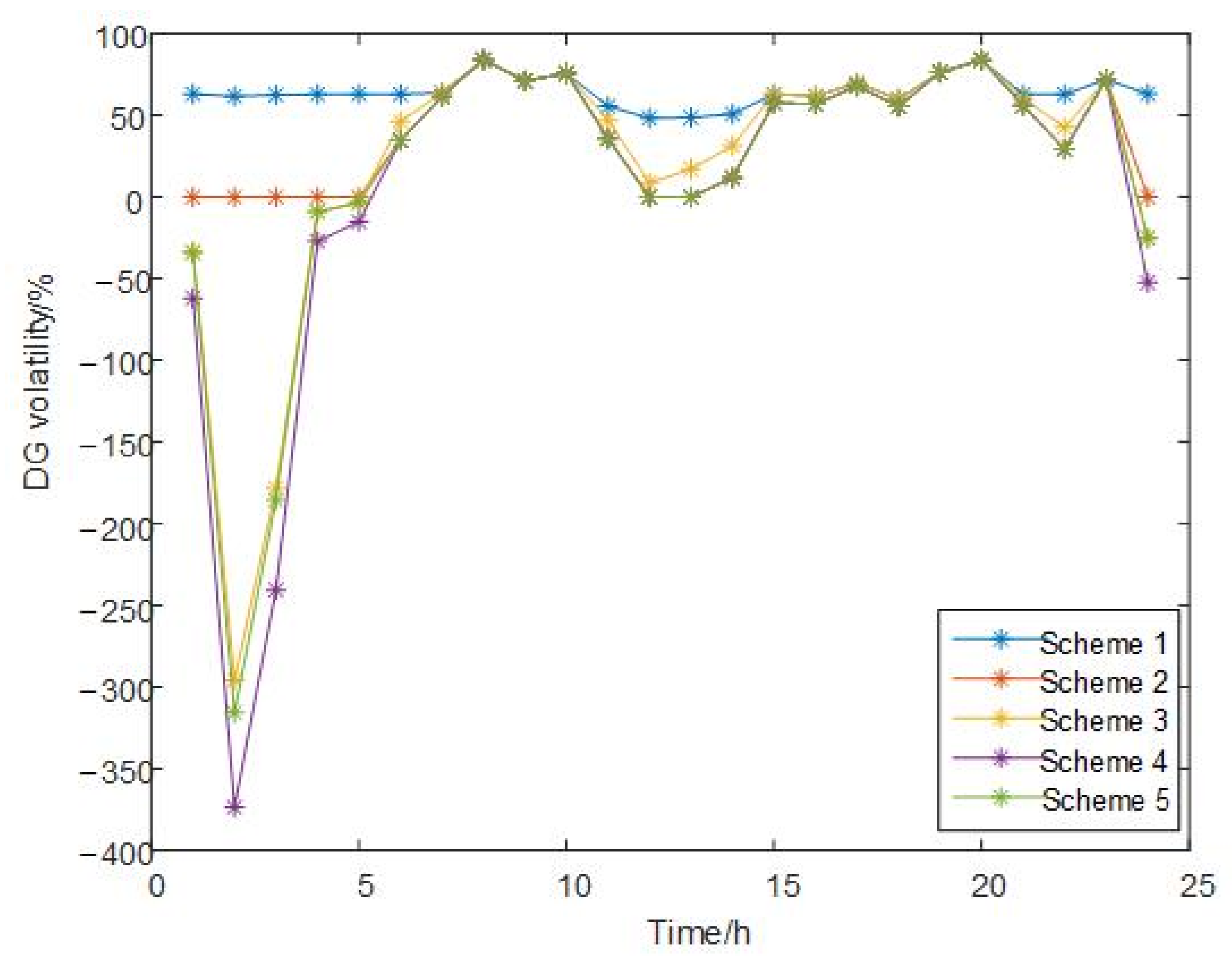
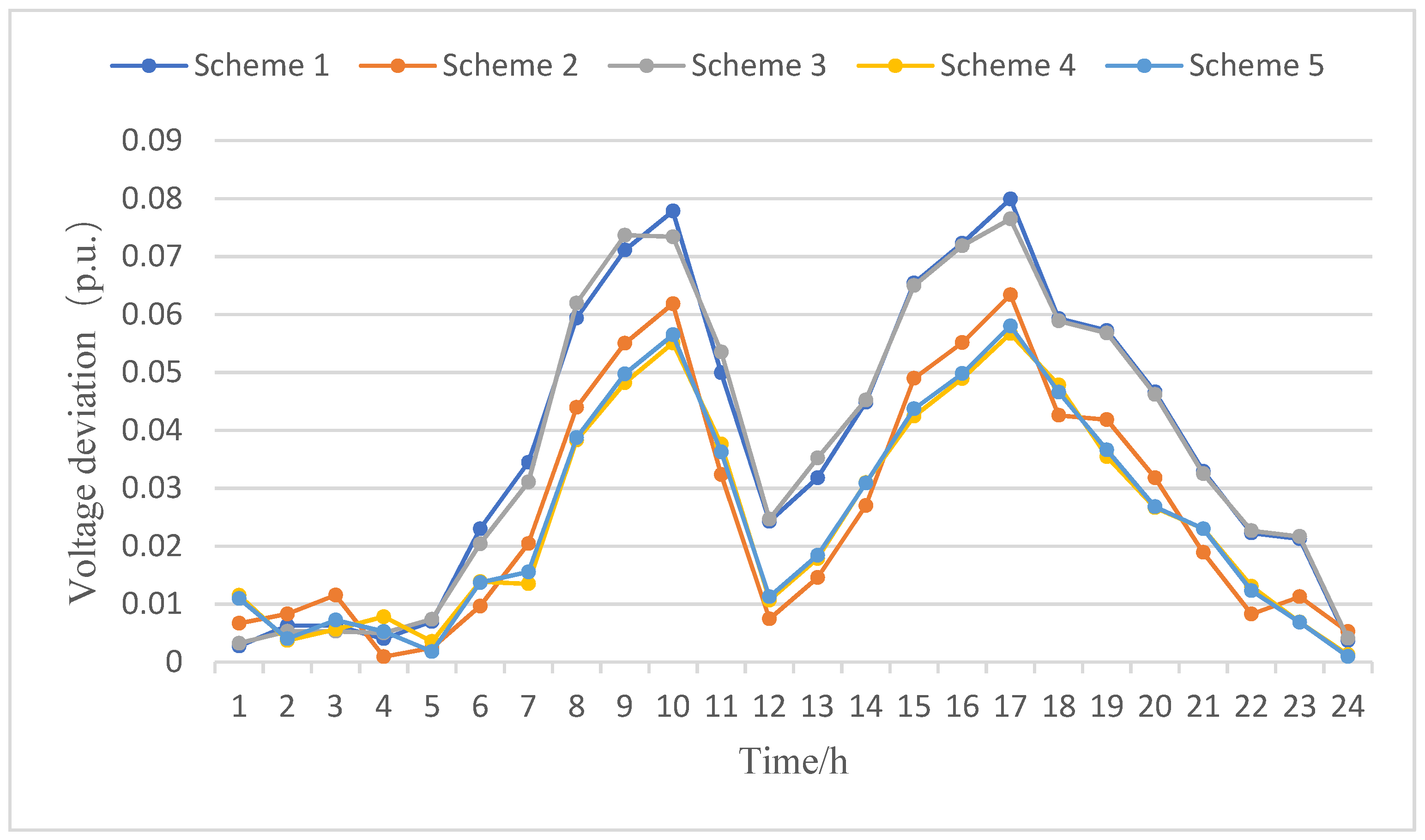
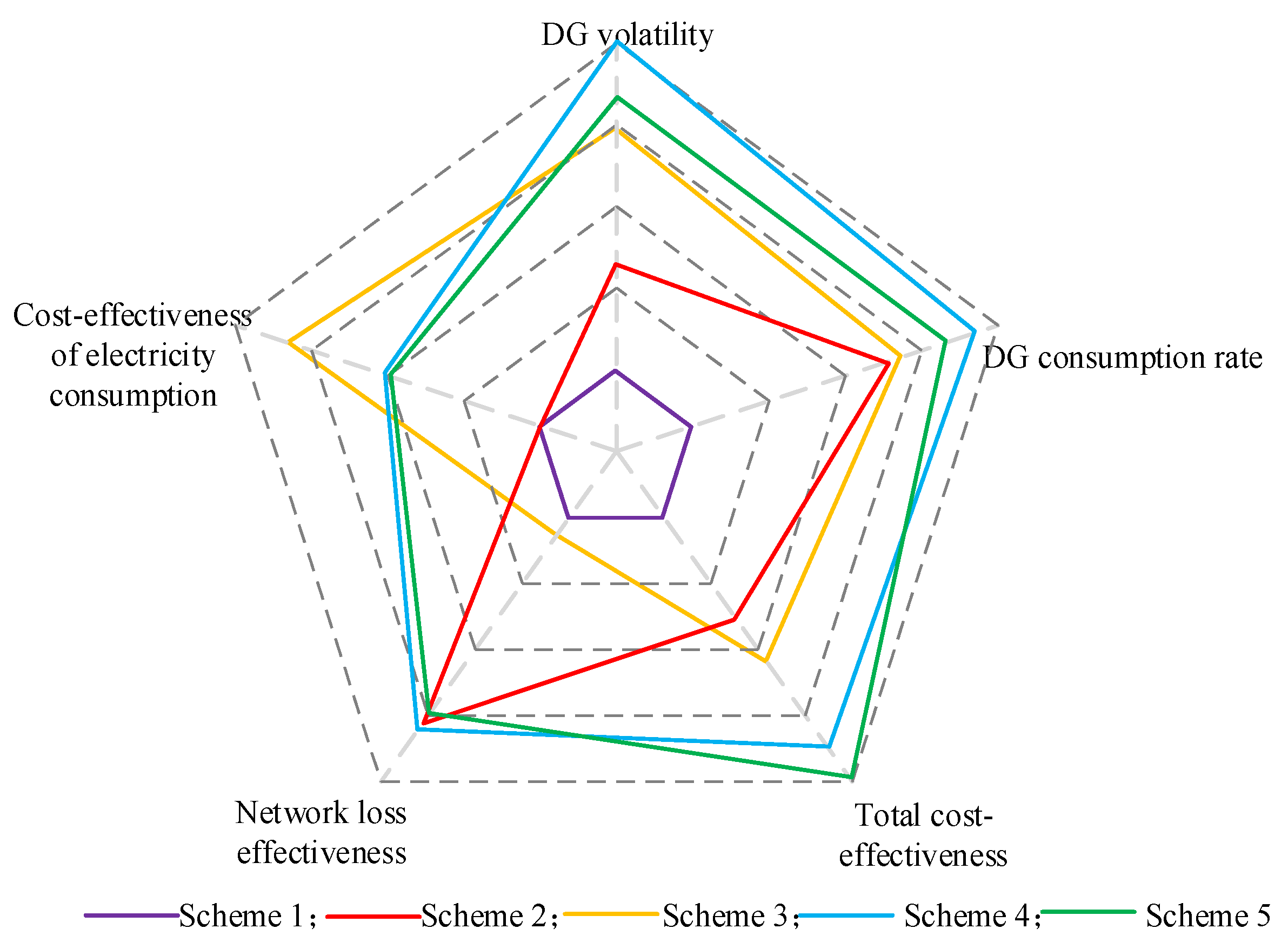

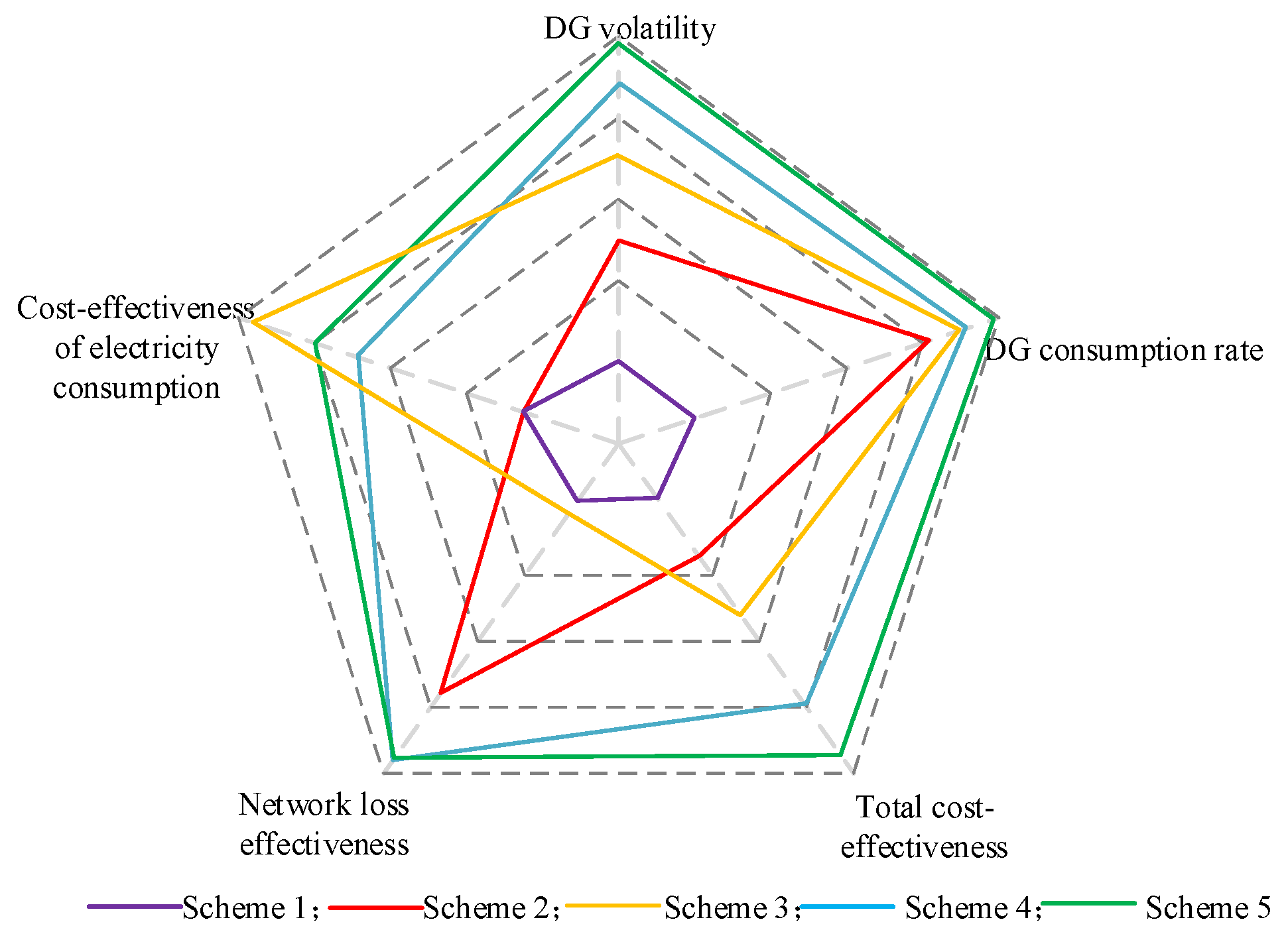
| Parameter | Value |
|---|---|
| Discount rate λ | 0.08 |
| Useful life of SOP/years | 20 |
| SOP Investment cost per unit capacity/(dollars/(kV∙A)) | 1500 |
| SOP unit optimized capacity/(kV∙A) | 10 |
| SOP loss factor | 0.02 |
| SOP maintenance cost factor | 0.01 |
| Useful life of ESS/years | 10 |
| ESS unit capacity cost/(dollars/(kW∙h)) | 400 |
| ESS unit optimized capacity/(kW∙h) | 100 |
| ESS Charge State Upper and Lower Limits | 0.9, 0.1 |
| ESS Running Costs/(dollars/(kW·h)) | 0.05 |
| ESS Charge and Discharge Efficiency | 0.9 |
| ESS Rated Capacity Range/(kW·h) | [500, 2000] |
| Unit network loss cost/(dollars/(kW·h)) | 0.5 |
| Scheme | Planning Content |
|---|---|
| 1 | No installation of SOP and ESS |
| 2 | Installation of SOP without ESS |
| 3 | Installation of ESS without SOP |
| 4 | Co-installation of SOP and ESS |
| 5 | Installation of E-SOP |
| Scheme | Flexibility Indicators | Fdown | |
|---|---|---|---|
| DG Consumption Rate Hxn/% | DG Volatility Hbd/% | ||
| 1 | 65.37 | 54.68 | 17.35 |
| 2 | 86.01 | 38.82 | 36.08 |
| 3 | 87.32 | 19.32 | 44.66 |
| 4 | 94.88 | 6.71 | 54.24 |
| 5 | 91.79 | 14.94 | 49.10 |
| Scheme | /Ten Thousand Dollars | /Ten Thousand Dollars | /Ten Thousand Dollars | /Ten Thousand Dollars | CPC/Ten Thousand Dollars | CL/Ten Thousand Dollars | Fup/Ten Thousand Dollars |
|---|---|---|---|---|---|---|---|
| 1 | 0 | 0 | 0 | 0 | 381.95 | 25.01 | 406.96 |
| 2 | 4.28 | 0.42 | 0 | 0 | 381.95 | 15.77 | 402.42 |
| 3 | 0 | 0 | 59.61 | 0.30 | 316.25 | 24.20 | 400.36 |
| 4 | 3.82 | 0.38 | 35.77 | 0.18 | 341.02 | 15.29 | 396.46 |
| 5 | 4.13 | 0.41 | 29.81 | 0.16 | 342.53 | 16.01 | 395.05 |
| Scheme | SOP Planning Results | ESS Planning Results |
|---|---|---|
| 1 | -- | -- |
| 2 | 6-16-33 (840 kVA) | -- |
| 3 | -- | 16 (300 kW, 2000 kW∙h) |
| 4 | 6-16-33 (750 kVA) | 16 (200 kW, 1200 kW∙h) |
| 5 | 6-16-33 (810 kVA) | 6-16-33 (150 kW, 1000 kW∙h) |
| Scheme | Combined Voltage Deviation p.u./×10−2 |
|---|---|
| 1 | 3.77 |
| 2 | 2.62 |
| 3 | 3.76 |
| 4 | 2.50 |
| 5 | 2.52 |
| Node i | Node j | Branch Impedance | Node j Load | Node i | Node j | Branch Impedance | Node j Load |
|---|---|---|---|---|---|---|---|
| 1 | 2 | 0.34 + j0.31 | 0 + j0 | 19 | 20 | 0.22 + j0.20 | 0 + j0 |
| 2 | 3 | 0.23 + j0.20 | 0 + j0 | 2 | 21 | 0.58 + j0.52 | 8.8 + j8.8 |
| 3 | 4 | 0.12 + j0.11 | 8.8 + j8.8 | 21 | 22 | 0.52 + j0.47 | 8.8 + j8.8 |
| 4 | 5 | 0.23 + j0.21 | 8.8 + j8.8 | 22 | 23 | 0.41 + j0.37 | 8.8 + j8.8 |
| 5 | 6 | 0.27 + j0.24 | 53.25 + j9.75 | 23 | 24 | 0.22 + j0.20 | 0 + j0 |
| 6 | 7 | 0.22 + j0.19 | 0 + j0 | 24 | 25 | 0.21 + j0.17 | 8.8 + j8.8 |
| 7 | 8 | 0.26 + j0.21 | 0 + j0 | 25 | 26 | 0.19 + j0.17 | 0 + j0 |
| 8 | 9 | 0.57 + j0.55 | 8.8 + j8.8 | 26 | 27 | 0.21 + j0.19 | 0 + j0 |
| 9 | 10 | 0.46 + j0.42 | 13 + j0.375 | 27 | 28 | 0.21 + j0.19 | 8.8 + j8.8 |
| 10 | 11 | 0.45 + j0.42 | 0 + j0 | 28 | 29 | 0.22 + j0.20 | 0 + j0 |
| 11 | 12 | 0.50 + j0.43 | 40.375 + j6.29 | 29 | 30 | 0.56 + j0.51 | 0 + j0 |
| 12 | 13 | 0.43 + j0.39 | 8.8 + j8.8 | 30 | 31 | 0.21 + j0.29 | 8.8 + j8.8 |
| 13 | 14 | 0.42 + j0.38 | 8.8 + j8.8 | 31 | 32 | 0.32 + j0.32 | 14.5 + j1 |
| 14 | 15 | 0.21 + j0.19 | 17.58 + j17.58 | 32 | 33 | 0.47 + j0.43 | 0 + j0 |
| 15 | 16 | 0.24 + j0.22 | 8.8 + j8.8 | 3 | 34 | 0.99 + j0.89 | 8.8 + j8.8 |
| 16 | 17 | 0.19 + j0.17 | 8.8 + j8.8 | 34 | 35 | 0.68 + j0.62 | 8.8 + j8.8 |
| 17 | 18 | 0.26 + j0.23 | 13 + j2.25 | 7 | 36 | 0.19 + j0.17 | 8.8 + j8.8 |
| 18 | 19 | 0.22 + j0.20 | 8.92 + j1.375 | 36 | 37 | 0.55 + j0.50 | 8.8 + j8.8 |
| Scheme | SOP Planning Results | ESS Planning Results | Fup /Ten Thousand Dollars | Fdown |
|---|---|---|---|---|
| 1 | -- | -- | 295.73 | 14.83 |
| 2 | 4-20-33 (660 kVA) | -- | 292.56 | 33.24 |
| 3 | -- | 16 (330 kW, 1800 kW∙h) | 289.32 | 42.55 |
| 4 | 4-20-33 (420 kVA) | 16 (200 kW, 1300 kW∙h) | 281.71 | 52.63 |
| 5 | 4-20-33 (510 kVA) | 4-20-33 (160 kW, 900 kW∙h) | 286.42 | 49.47 |
Disclaimer/Publisher’s Note: The statements, opinions and data contained in all publications are solely those of the individual author(s) and contributor(s) and not of MDPI and/or the editor(s). MDPI and/or the editor(s) disclaim responsibility for any injury to people or property resulting from any ideas, methods, instructions or products referred to in the content. |
© 2024 by the authors. Licensee MDPI, Basel, Switzerland. This article is an open access article distributed under the terms and conditions of the Creative Commons Attribution (CC BY) license (https://creativecommons.org/licenses/by/4.0/).
Share and Cite
Li, J.; Zhang, Y.; Lv, C.; Liu, G.; Ruan, Z.; Zhang, F. Coordinated Planning of Soft Open Points and Energy Storage Systems to Enhance Flexibility of Distribution Networks. Appl. Sci. 2024, 14, 8309. https://doi.org/10.3390/app14188309
Li J, Zhang Y, Lv C, Liu G, Ruan Z, Zhang F. Coordinated Planning of Soft Open Points and Energy Storage Systems to Enhance Flexibility of Distribution Networks. Applied Sciences. 2024; 14(18):8309. https://doi.org/10.3390/app14188309
Chicago/Turabian StyleLi, Jingyu, Yifan Zhang, Chao Lv, Guangchen Liu, Zhongtian Ruan, and Feiyang Zhang. 2024. "Coordinated Planning of Soft Open Points and Energy Storage Systems to Enhance Flexibility of Distribution Networks" Applied Sciences 14, no. 18: 8309. https://doi.org/10.3390/app14188309
APA StyleLi, J., Zhang, Y., Lv, C., Liu, G., Ruan, Z., & Zhang, F. (2024). Coordinated Planning of Soft Open Points and Energy Storage Systems to Enhance Flexibility of Distribution Networks. Applied Sciences, 14(18), 8309. https://doi.org/10.3390/app14188309





